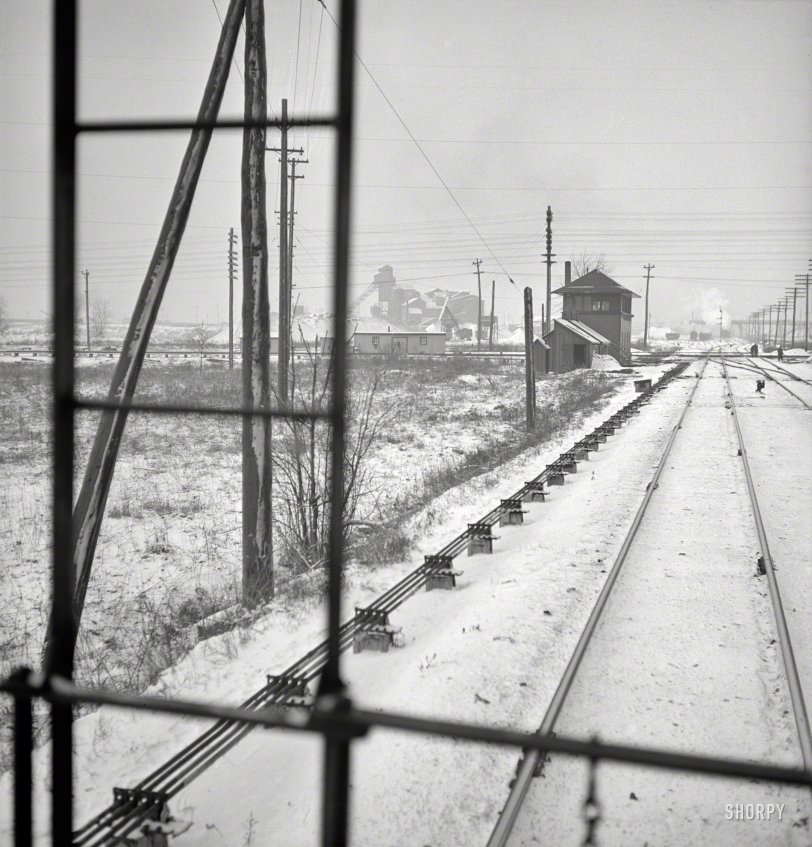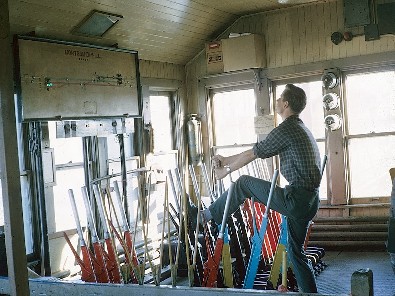


Framed or unframed, desk size to sofa size, printed by us in Arizona and Alabama since 2007. Explore now.
Shorpy is funded by you. Patreon contributors get an ad-free experience.
Learn more.

- Lofty addition
- In 1912
- Keenan Building
- Six years old
- Taken from the P.J. McArdle Roadway?
- It stood only 47 years
- Three track mind
- Incline to the right
- Reach for the sky, 1912 style
- No clean sweep
- Same Job Title, Same Face
- Sadly Lost
- Beautiful ...
- Where you get your kicks
- Aim High
- Pueblo Revival sisters
- Pueblo Neoclassicism
- Milk Man
- Regional dialect.
- Spielberg's inspiration
- Great Photo
- Loaf Story
- Do you still have the Rakes category?
- Could almost be a scene from the 1957 movie 'Hell Drivers'
- The Wages of Fear.
- Conspicuous by their absence
- Got Milk?
- All that aluminum
- No lefties
- Smoke 'em if you've got 'em
Print Emporium
Harbor Belt: 1943

January 1943. "Freight operations on the Indiana Harbor Belt railroad between Chicago and Hammond, Indiana. The train passes many interlocking towers on the way and the conductor watches them for any special messages." Medium-format negative by Jack Delano, Office of War Information. View full size.
Manual interlockings photo
kreriver, what tower is shown in the photo you posted? It doesn't look like an IHB tower to me.
McCook: Home of EMD
Just on the other side of that aggregate pile in the background is General Motor's Electro-Motive Division, at 55th St. and old U.S. 66. All new EMD diesel locomotives delivered from this plant were handled by the IHB first.
Manual interlockings
The Harbor (IHB) had about a dozen or so interlocking towers back in the day, each one a busy place. I’m going to hazard a guess and suggest, for several reasons, the featured picture is the old IHB Ivanhoe tower, controlling movements of IHB and EJE traffic across the diamond about a mile east of Gibson at 160th Street. To the best of my knowledge: 1) Dolton Tower, controlling movements across the UP (north/south) and IHB (east/west) is still manned by an interlocking operator, 2) the GTW tower at Blue Island is still a manual interlocking, as is 3) Gibson Yard west end tower. At one point most, if not all, of these towers were "strongarm" plants. Remote controlled switches and signals have replaced the Stone Age technology, but the operator headaches can still be intense. He/she has to balance the interests and wishes of a yardmaster, a dispatcher, and a trainmaster, among others, each of which has their own priorities. Anyone who has ever worked a Chicago tower will know well what I speak of.
Attached is a picture of a strongarm operator lining a switch, one perhaps several hundred feet from the tower.

Location on "The Harbor."
Looking to the northwest at McCook, the Santa Fe crossing. I recognize the jog in the mainline on the other side of the diamond.
I H B R R
Seems the name went from Indiana Harbor Belt Rail Road to Indiana Harbor Belt R R, to Indiana Harbor Belt, then to Harbor Belt finally on its later diesel engines it was just Harbor.
An Armstrong Operation
When I was about 14 a tower man in Cumberland, MD let me try my hand at an interlocking lever. It wouldn't budge. The name is apt. That tower also had a timer which had to be set before any levers could be thrown, then each lever was locked in its new position until the timer expired after the next train passed. It was to make the operator think out his moves carefully, and prevent last minute changes.
Interesting
I don't know why, but I love the wintry-scene railway photographs.
I am curious what the lines running along the track are, on the left. Are they signal lines? They seem too far away from the tracks to be an electric engine power source, and the supports would interfere with power engine power shoes.
>>>>>>> Thanks to Olde Buck! They are control rods for signals and turnouts, which makes much more sense. I've read that those controls took some muscle to use, and no wonder!
Wooden Dodo
Virtually every track crossing of any importance had an interlocking tower guarding it; some were single story shantys, and some were massive brick or block structures. But most were very much like this one. As busy as this tower looks capable of, it likely was manned 24/7.
The rods visible left of the track physically align switches, derails and even semaphore signals. More modern interlockings had electric motors to move these things, although I worked around such a plant as this well into the 1980's.
Towers such as this are Dodo birds, or very nearly so. The function of protecting a level crossing,interlocking or a junction is today controlled from many miles away, and the towers have been falling all over the country for decades; if any are still in use for intended purpose, they are few in number.
























On Shorpy:
Today’s Top 5